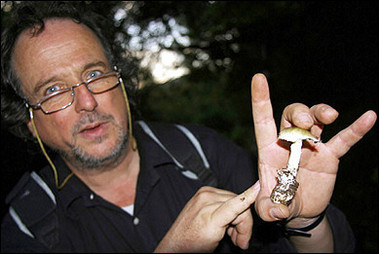Spain’s ‘Doctor Mushroom’ always on call
December 14, 2005 - Agence France Presse

“You’ll have to excuse me for a moment. A doctor in Girona has called for help because some people ate the wrong mushrooms,” says Doctor Enric Gracia before disappearing into the bowels of the University of Barcelona’s biology department.
“It reminds me of cases we saw a few years ago in France and Poland where a few people died,” Gracia says a while later, en route to the hills above Barcelona to pick mushrooms for a course he is teaching.
Yikes.
Despite the risks, Spaniards are captivated by mushrooms to a degree that amazes even Gracia, a doctor in biology specializing in mushroom cultivation. “I’ve been talking about them for 30 years and I still don’t know why people are so interested,” he says with a grin.
There is no better guide to the national fascination with fungi than Gracia, who could best be described as Spain’s “Doctor Mushroom.” A frequent radio commentator and the author of dozens of articles, he has recently finished what is already a best-selling field guide to mushrooms, edible or otherwise.
Statistically, everyone in Spain’s Catalan region goes mushroom picking at least once a year, he says. “A couple years ago, we did a mushroom exposition on the Ramblas (Barcelona’s main drag) and 12,000 people came in two days—we didn’t even have time to put a sign up!”
Popularity has its pitfalls, though. This year there has been a spike in poisonings for the first time in years, an increase that Gracia attributes to the weather. A dry summer followed by a wet fall leads to a shortage of the most common varieties, prompting people to be more adventurous in what they pick.
“Some of the people are in hospital, others are at home, but their kidneys might start failing in a few days,” he says, referring to the Girona poisoning.
Even Gracia himself has been fooled. Six years ago he thought he was picking a savory local variety, but it turned out to be a much less prized type found only near beaches. “My confidence was shot,” he admits, bad memories still lingering in his voice.
Up on the hill, however, he’s all enthusiasm. A basket he’s brought along remains empty for about 30 seconds after he parks his 4-wheel-drive. He picks almost everything he finds—edible, non-edible and toxic—so he has examples of each to show to his class.
“Sixty-two percent of what we find around here are edible, 30 percent inedible, five percent toxic and maybe three species are mortal,” he says, citing numbers that help explain the popularity of identification courses and field guides.
He picks one apart to see how it has weathered the past week of wetness then stops in his tracks. “Ooh good! This one’s deadly!”
As in, “You eat, you die?”
“Yes, of course.”
A few paces later, he veers off to the left, and lets out a yelp of sheer delight. “This is the deadliest mushroom in the world,” he says, holding up a green-tinged amanita phalloides.
Along with the deadly varieties, he picks several edible types to show to his class. They will not go to waste. “I love to do a mushroom-infused oil, or pickle them in oil,” he says, eyes bright. “It’s also perfect for salads and on tomatoes. Oyster mushroom infused oil is fantastic!”
Catalans have a particular weakness for “rovellons” (Catalan for “lactarius sanguifluus,” or saffron milk cap), which are displayed bottoms-up with the stem cut off. The choicest cost a hefty 25 euros per kilo.
Down at Pinotxo, a food bar inside the city’s famous Boqueria market, brothers Albert and Jordi Asim cook up more reasons why Spaniards are such mushroom fanatics.
Exhibit A: a “revuelto de setas con tres butifarras” (translation: a thick stew made with at least six mushroom varieties and three types of sausage). The dish is so popular, it only makes it through the first half of the day before the last plate is ordered.
Back in the hills above town, Dr. Gracia reminisces about his formative fungi experience.
“When I was nine, I went with my family to pick mushrooms near our home. We found some of the best in the Mediterranean,” he explains. “They were so numerous, my father started to doubt that we had the real thing, so we threw them away,” even though they were edible.
There is a lingering grudge in his voice as he tells the story. Then Gracia grins. “Ever since, I go into the field alone.”
This article also appeared with: TodayOnLine.com, New Straits Times Online